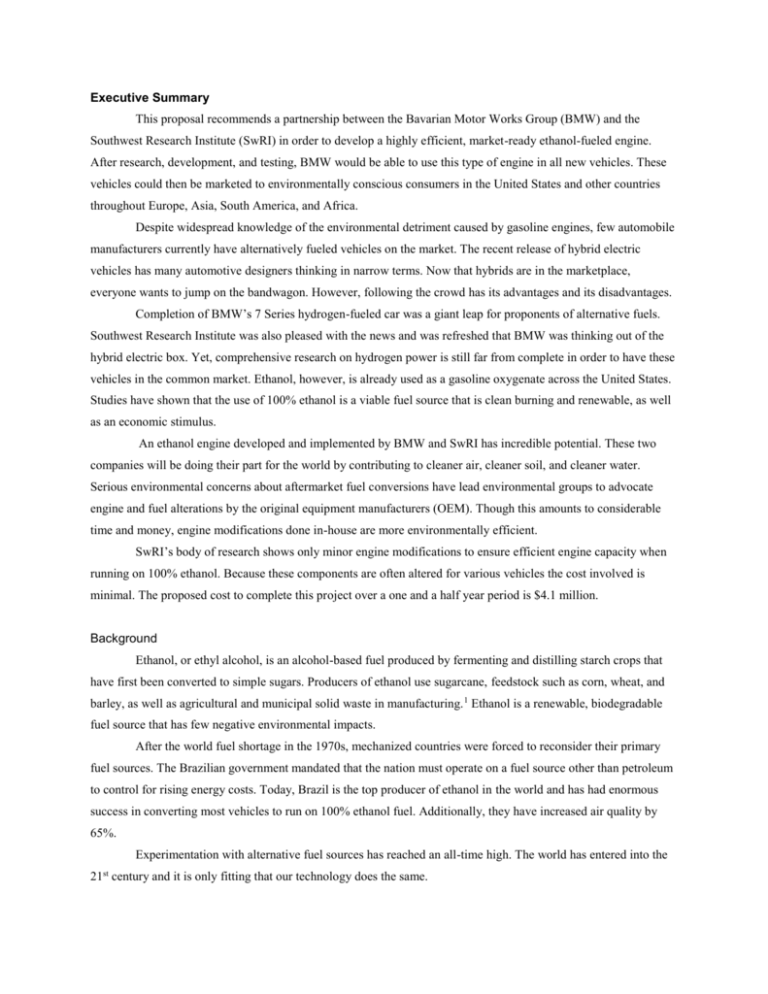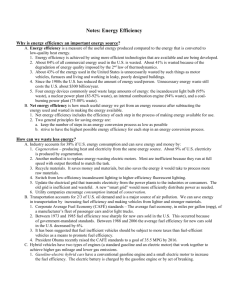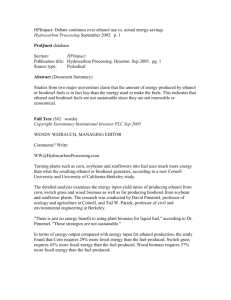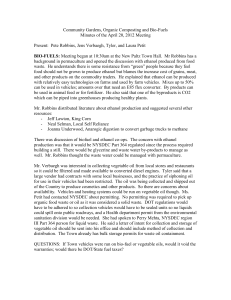ethanol fueled vehicle
advertisement

Executive Summary This proposal recommends a partnership between the Bavarian Motor Works Group (BMW) and the Southwest Research Institute (SwRI) in order to develop a highly efficient, market-ready ethanol-fueled engine. After research, development, and testing, BMW would be able to use this type of engine in all new vehicles. These vehicles could then be marketed to environmentally conscious consumers in the United States and other countries throughout Europe, Asia, South America, and Africa. Despite widespread knowledge of the environmental detriment caused by gasoline engines, few automobile manufacturers currently have alternatively fueled vehicles on the market. The recent release of hybrid electric vehicles has many automotive designers thinking in narrow terms. Now that hybrids are in the marketplace, everyone wants to jump on the bandwagon. However, following the crowd has its advantages and its disadvantages. Completion of BMW’s 7 Series hydrogen-fueled car was a giant leap for proponents of alternative fuels. Southwest Research Institute was also pleased with the news and was refreshed that BMW was thinking out of the hybrid electric box. Yet, comprehensive research on hydrogen power is still far from complete in order to have these vehicles in the common market. Ethanol, however, is already used as a gasoline oxygenate across the United States. Studies have shown that the use of 100% ethanol is a viable fuel source that is clean burning and renewable, as well as an economic stimulus. An ethanol engine developed and implemented by BMW and SwRI has incredible potential. These two companies will be doing their part for the world by contributing to cleaner air, cleaner soil, and cleaner water. Serious environmental concerns about aftermarket fuel conversions have lead environmental groups to advocate engine and fuel alterations by the original equipment manufacturers (OEM). Though this amounts to considerable time and money, engine modifications done in-house are more environmentally efficient. SwRI’s body of research shows only minor engine modifications to ensure efficient engine capacity when running on 100% ethanol. Because these components are often altered for various vehicles the cost involved is minimal. The proposed cost to complete this project over a one and a half year period is $4.1 million. Background Ethanol, or ethyl alcohol, is an alcohol-based fuel produced by fermenting and distilling starch crops that have first been converted to simple sugars. Producers of ethanol use sugarcane, feedstock such as corn, wheat, and barley, as well as agricultural and municipal solid waste in manufacturing. 1 Ethanol is a renewable, biodegradable fuel source that has few negative environmental impacts. After the world fuel shortage in the 1970s, mechanized countries were forced to reconsider their primary fuel sources. The Brazilian government mandated that the nation must operate on a fuel source other than petroleum to control for rising energy costs. Today, Brazil is the top producer of ethanol in the world and has had enormous success in converting most vehicles to run on 100% ethanol fuel. Additionally, they have increased air quality by 65%. Experimentation with alternative fuel sources has reached an all-time high. The world has entered into the st 21 century and it is only fitting that our technology does the same. Statement of Problem Gasoline has been the major source of automobile fuel for the last 100 years. This fuel was chosen over any other type because, at the time, it was inexpensive, easy to refine, and easy to transport. The automotive industry built internal combustion engines to run off of gasoline and has continued to do so through the present. However, the climbing costs of crude oil, as well as environmental costs, have caused concerned groups to seek alternative sources of fuel. Environmental Issues Emissions from gasoline-powered engines have contributed to global warming by releasing chemicals that transform into low-level ozone or greenhouse gases. These chemicals include carbon monoxide (CO), carbon dioxide (CO2), nitrogen oxides (NOx), sulfur dioxide (SO2), hydrocarbons, volatile organic compounds, and particulate matter. Greenhouse gases cause global climate change by generating low-level atmospheric warming. In addition to harming the environment, gasoline fuel and greenhouse gases directly relate to issues of public health, particularly asthma and lung cancer. Recently, the United States Environmental Protection Agency (EPA) announced plans to begin mainstreaming alternative fuel sources in an effort to increase the quality of the environment and public health. Currently, automobile manufacturers such as Ford, GM, Volvo, Daimler Benz, Toyota, and Honda are experimenting with alternative fuel vehicles. Though most experiments are on electric-gasoline hybrids, few companies are also researching ethanol and methanol biofuel blends. As a leader in luxury vehicles, BMW Group should consider experimenting with ethanol-fueled vehicles, in conjunction to the current work on the 7 Series hydrogen-fueled sedan. Finite Resource Issues Dependence on foreign crude oil supplies is cause of great consternation within the United States. Today, America imports over half of its annual oil supply costing taxpayers roughly $126 per barrel after tax and interest, as estimated by the United States General Accounting Office. 2 As political unrest rocks the Middle East, America has to spend more money and resources to protect its dwindling supply. International governments, and especially the United Nations, are recognizing that there is a finite amount of crude oil in the world and industrialized nations’ energy use will soon cause the price of petroleum products to skyrocket. With crude oil consumption increasing (Figure 1) and supply and American oil production decreasing, automobile companies must take necessary action to promote the use of alternatively fueled vehicles not only in America, but across the globe. 2 Average per Million Barrels per day North American Consumption of Refined Products from 1982-2002 22000 21000 20000 19000 18000 17000 16000 15000 North America (Including Canada and Greenland) Linear (North America (Including Canada and Greenland)) 1982 1987 1992 1997 2002 Figure 1: North American refined product consumption drastically increased over the past 20 years. (Information Source: OPEC Annual Statistical Bulletin 2002)3 Aftermarket Conversion Issues Environmentally conscious consumers who want the comfort of a luxury vehicle tend to either purchase from a competitor producing alternative fuel vehicles or are forced to install aftermarket fuel conversion systems. Aftermarket fuel conversion kits transform vehicles originally dedicated to run on one type of fuel to run on an alternative fuel. Conversion companies perform the installation after the vehicle has been sold to the consumer. Not only are high-quality conversion kits costly to the consumer (ranging between $1,000 to $5,000), but also the engine modifications tend to compromise performance and advanced engine technology. In addition, emission tests of retrofit modifications conclude that, contrary to belief, emissions of pollutants often increase. Researchers are still working to find the reason for increased emissions. A likely explanation is that additional fuel tanks, lines, pressure regulators, and electronic control systems cause the engine work harder, therefore reducing performance and fuel economy. Profitability and Competitive Issues Without considering alternative fuel vehicles other than liquid hydrogen already prototyped, BMW can expect a decline in sales over the next six years. Market forecasters predict that environmentally informed car buyers will more likely be concerned with issues of alternative fuels along with current car buying factors through 2009. Toyota has already introduced hybrid technology into the public market with the development of the Prius and Honda with the development of the new Insight. GM, Ford, and Daimler Benz are following close behind with compressed natural gas (CNG), liquefied petroleum gas (LPG), and biodiesel powered vehicles. Though hydrogen powered vehicles, notably the BMW 7 Series, are gaining recognition as an alternative fuel, liquid hydrogen is nevertheless a highly volatile fuel that needs further research to be considered safe for public use. Another major disadvantage is that hydrogen has 14 times less energy than the same volume of gasoline. Therefore, large quantities of hydrogen are needed to power these vehicles in order to get the same engine capability as gasoline. Investing money and resources into fuels other than hydrogen will greatly increase the ability to bring these vehicles to the public market, without extensive research and development. 3 Statement of Solution The solution to this multi-tiered problem is simple and comes with many benefits. The Southwest Research Institute proposes to form a partnership with Bavarian Motor Works Group to quickly develop an engine that will run exclusively on ethanol biofuel. This process will require only slight modifications from the current engine design. Component Modifications Since the EPA mandates on using oxygenated gasoline (gasoline blended with ethanol or methanol), car manufactures have reconfigured elastomer and metal engine parts to accommodate for ethanol’s corrosive properties. Stainless steel or anodized aluminum have replaced much of the once all-aluminum components of engine systems such as fuel lines. Recently, preference has dictated the use of anodized aluminum to produce lighter weight vehicles. Fuel diaphragms and hoses need to be checked for their elastomeric properties and their relationship to deterioration from ethanol. They would have to be changed to high-density nylon polyethylene or polypropylene, as opposed to polyurethane, which cracks and softens through contact with ethanol. 4 There is no need to change the metal or elastomer components of BMW’s current engines, as they have already been configured for use of ethanol blends. Studies have shown that ethanol increases the thermal efficiency of engines by thirty-six percent over gasoline engines with the same compression ratio of 8.5:1. BMW could continue to use their present combustion chambers and compression ratios used for gasoline-powered vehicles, but increase the efficiency by using ethanol. The 2003 760Li has a compression ratio of 11.3:1, which would be sufficient for an ethanol-powered version. To improve performance and horsepower, we can decrease the area of the combustion chamber, thus increasing the compression ratio. Optimum ratios for ethanol fall in the 12.5:1 range. As long as the pistons, rings, and heads are able to currently withstand such a high compression ratio, then there will be no need to change those internal components. The most notable modification to the engine would be adjusting the size of the injector jets. Because a greater volume of atomized ethanol is needed to supply the engine, engineering must increase the diameter of the injector jets by about 35%. Because ethanol contains two-thirds the energy as the same volume of gasoline, and therefore requires more energy than gasoline to achieve the same amount of power, a greater volume of vaporized ethanol must be injected into the cylinder. The final modification would be to create a collapsible fuel tank. Ethanol, though less explosive than gasoline, becomes unstable at air-alcohol mixtures of 4-13% alcohol.5 A collapsible fuel tank or bladder, also known as a pillow tank, would ensure the proper fuel-air ratio as the amount of fuel decreases through consumption. Not only does a collapsible fuel tank increase safety standards, but it also decreases the probability that the liquid fuel will vaporize prior to transmission. These tanks are currently in use by military and racing vehicles. 4 Additional Components Because of ethanol’s high heat of vaporization, cold-starting and misfiring can be common problems. Unmodified engines powered by 100% ethanol will not start in temperatures below 15°C 6. However, engineers can easily remedy this issue by installing in-line fuel heaters. These heaters would warm the fuel to the lowest temperature possible for vaporization, at which point the injector jets would spray atomized ethanol into the cylinder head, allowing for proper ignition. Another option is the use of an ethanol-ether or propane starting fluid. These mixtures significantly reduce the fuel’s heat of vaporization, therefore allowing ignition in temperatures below 15°C. Vehicle Performance Benefits These slight modifications translate into significant gains in vehicle performance when using this alternative fuel. Ethanol’s octane rating is 113, far surpassing premium gasoline octane levels (Figure 2). This means that ethanol can withstand a high compression before the pressure ignition point. Ethanol’s octane rating is the highest to resist premature combustion. Increase in compression results in greater horsepower and higher performance. Moreover, altering the fuel system to run on ethanol by the original equipment manufacturer (OEM) decreases aftermarket conversions. These conversions, which often compromise engine operation and disrupt the initial engine calibrations, can reflect badly on automobile companies, though they are not actually at fault. Because BMW Group has a commitment to providing high performance, high quality vehicles, it is important that their vehicles maintain standards of efficiency. Octane Rating of Various Fuel Types Octane Rating (ROM) 120 100 106 87 89 91 113 Regular Unleaded Gasoline Mid-Grade Gasoline 107 93 High-Grade Gasoline 80 Super High-Grade Gasoline Methanol 60 40 Ethanol 20 0 Propane (LPG) Types of Fuels Figure 2: Ethanol has the highest octane rating compared to gasoline, methanol, and propone fuels. 5 Environmental Benefits The largest benefit to using ethanol as an alternative fuel is because it is a cleaner burning fuel than gasoline. Because ethanol’s chemical structure includes oxygen, combustion occurs more completely, thus reducing the number of hydrocarbons and other chemicals in tailpipe emissions. Of all the industrialized countries in the world, the United States emits the largest amount of contaminants, primarily carbon dioxide, into the atmosphere.7 Vehicles designed to run on neat ethanol discharge 80-90% less carbon monoxide, hydrocarbons, nitrogen oxides, volatile organic compounds, and particulate matter. Ethanol’s high octane rating also reduces the amount of carcinogens released by gasoline emission because gasoline engines use toluene and benzene as octane boosters. 8 As a result, these vehicles reduce harmful greenhouse gases and low-level ozone, which are the main contributors to public health problems. Economic Benefits The use of ethanol fuel provides economic benefits not only to BMW Group, but also to the American economy. On the corporate level, profitability stems from research benefits, reputation benefits, marketability, and federal funding benefits. On the national level, profitability includes CAFE benefits, ethanol infrastructure benefits, and domestic economic dependence benefits. National benefits CAFE benefits. The Corporate Average Fuel Economy (CAFE) standards set the criteria for the average miles per gallon that new light-duty trucks and passenger vehicles must attain to be sold in the United States. These standards currently range between 20-27 miles per gallon. The CAFE has successfully decreased, but only slightly, fuel consumption by demanding that vehicles have more efficient engines to maintain these standards. With the introduction of ethanol-powered vehicles into the common market, policymakers could increase the CAFE standards, further reducing American oil consumption, and thus lessening the dependence on foreign oil sources. Domestic energy dependence. The development of the ethanol infrastructure in the United States will result in economic independence from oil producing countries in the Middle East. The US General Accounting Office estimates that increased ethanol production of an additional one to two billion gallons per year will result in a net savings of $500-600 million.9 The outcome of widespread use of ethanol-powered vehicles will be an economic burst in the employment sector, creating new jobs at ethanol production plants, as well as increasing the need for energy crops. Corporate benefits Research. Southwest Research Institute has been testing and designing engines for the last 50 years. We have done considerable research on ethanol-powered vehicles, including fuel economy, emissions, and engine efficiency. We have won over 25 research and development awards since 1971, and we currently hold the rights to three patents. SwRI has achieved internationally recognized quality certifications such as ISO 9001, as well as the environmental 6 management certification ISO 14001.10 Our engineers will bring their advanced knowledge of ethanol engines to the design table with BMW’s research and design engineers. The research knowledge that will result from this partnership will benefit both groups. Maintaining reputation. BMW named its first environmental manager in 1973 and has long been a leader in sustainable vehicle production. The 2001 United Nations “Cleaner Production” declaration continues to set BMW apart from other automobile manufacturers. The voluntary declaration obligates BMW to avoid environmentally harmful processes from the first stages of production through completion. 11 Creating an environmentally friendly ethanol-powered engine with the engineers of Southwest Research Institute propagates and promotes BMW’s image as an environmentally concerned automobile manufacturer. Marketability. The developing trend in both the United States and Europe is an environmentally conscious uppermiddle class. BMW’s target consumers are in this upper echelon of society. An ethanol-powered BMW would increase the marketability of the vehicles to the environmentally minded consumer. Additionally, the extensive use of ethanol fuel in Western Europe demands the need for ethanol-powered luxury vehicles. These vehicles increase the options of target consumers. Tax Incentives and US Federal Funding. Currently, the US federal and state governments offer short-term tax deductions to consumers who purchase alternatively fueled vehicles. These deductions range from $1,000-$2,000, depending on the date the vehicle is purchased. The EPact program, the 1992 Energy Policy Act, offers tax incentives to companies that convert gasoline vehicles to alternative-fueled vehicles12. BMW may qualify for this incentive to decrease costs in engine redesign and manufacturing. Summary The two major benefits of developing an ethanol-powered engine are an increase in environmental health and an increase in profitability. SwRI projects that marketable ethanol-powered BMW vehicles can enter the market in early to mid 2005. Facilities The design and engineering partnership between BMW Group and Southwest Research Institute will not require additional facility space. SwRI’s current facility in San Antonio, Texas houses over two million square feet of research and development space. This space includes laboratories for simulated climate testing and the latest technology in emissions detection. These facilities support about 1,500 client projects a year. To lessen travel time, we have facilities in Washington, DC, Ogden, Utah, Boulder, Colorado, Oklahoma City, Oklahoma, and WarnerRobins, Georgia. If there are time constraints, SwRI has a state-of-the-art video teleconferencing center that allows us to conduct business with clients anywhere in the world.13 7 BMW’s DesignWorks space in California provides design laboratories and software specific to BMW’s enterprise. The western headquarters in Los Angeles houses an emissions testing lab, and the Palo Alto technology office supplies a secondary design headquarters. Both SwRI’s and BMW’s existing facilities will satisfy laboratory needs.14 Personnel The chain of command follows a top-down hierarchy. This project will require four levels of personnel in order to complete the plan timely and efficiently. CEO/Presidents – CEO/President of BMW Helmut Panke and SwRI president Dan Bates will make all final financial decisions related to the project. They will receive monthly progress reports from the vice presidents. Vice Presidents – BMW Vice President of Assembly Dieter Lauterwasser and SwRI Vice President Nigel Gale will ensure that the project is on budget and on time. They will receive weekly progress reports from design directors and senior engineers. Design Directors and Senior Engineers – BMW’s American Global Design Director Chris Bangle and SwRI’s Director of Design and Development James Cole will work closely with the senior engineers from BMW and SwRI to ensure proper design and prototyping. Engineers and Scientists – Engineers and Scientists from both companies will incorporate various ideas and techniques to come up with a working ethanol engine that can be used in BMW vehicles. Costs Because most costs are configured according to an hourly rate, the following figures are hourly rates for some of the principle personnel who will work on this project. Labor Category Fiscal Fiscal Year 04 Year 05 Director-R&D $266.99 $276.44 Program Manager $177.12 $183.38 Principal Engineer $168.87 $174.84 Sr. Research Engineer $149.69 $154.97 Staff Drafter $ 81.50 $ 84.37 Senior Drafter $ 63.08 $ 65.32 Engineer $ 97.38 $100.83 Designer $ 97.79 $101.23 Engineering Technologist $ 71.23 $ 73.77 Figure 3: The chart provides hourly rates for personnel during the 2004 and 2005 fiscal years.15 8 Estimated projections of hourly rates and laboratory fees equate to $4.1 million over one and a half years. The cost analysis includes various stages of production: initial research, designing, prototyping and testing, and manufacturing. Conclusion This partnership will be beneficial to everyone involved, as well as the earth on which we live. Ethanolpowered vehicles create cleaner air, cleaner soil, and cleaner water. With BMW’s help, we can look forward to a healthy tomorrow. 1 Alternative Fuels Data Center. 5 November 2003. 12 November 2003. <http://www.afdc.nrel.gov>. 2 United States General Accounting Office. 16 October 2003. 12 November 2003. <http:// www.goa.gov>. 3 Organization of Petroleum Exporting Companies. 4 December 2003. 28 November 2003. <http://www.opec.org>. 4 Roehr, M. (Ed.). (2001). The biotechnology of ethanol. Weinheim, Germany: Wiley-VCH. 5 Roehr, M. (Ed.). (2001). The biotechnology of ethanol. Weinheim, Germany: Wiley-VCH. 6 Renewable Fuels Association. 25 November 2003. 30 November 2003. <http://www.ethanolrfa.com>. 7 Nation Master. 18 October 2003. 3 December 2003. <http://www.nationmaster.com>. 8 Environmental Protection Agency. 14 November 2004. 16 November 2003. <http://www.epa.gov>. 9 United States General Accounting Office. 16 October 2003. 12 November 2003. <http:// www.goa.gov>. 10 Southwest Research Institute. 8 December 2003. 20 November 2003. <http://www.swri.edu>. 11 Bavarian Motor Works Group. 10 November 2003. 14 November 2003. <http://www.bmw.com>. 12 American Council for an Energy Efficient Economy. 3 December 2003. 3 December 2003. <http://www.aceee.org>. 13 Southwest Research Institute. 8 December 2003. 20 November 2003. <http://www.swri.edu>. 14 Bavarian Motor Works Group. 10 November 2003. 14 November 2003. <http://www.bmw.com>. 15 Southwest Research Institute. 8 December 2003. 20 November 2003. <http://www.swri.edu>. 9







